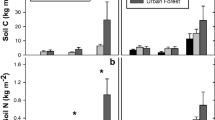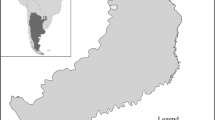Abstract
College and university campuses with a notable arboreal component provide unique opportunities for carrying out ecological research. The University of West Florida Campus Ecosystem Study (UWF CES) was established in 2019 as interconnected research to take advantage of the extensive arborescent nature of the UWF campus, particularly concerning longleaf pine (Pinus palustris). One of these investigations established permanent plots in forested sites of two contrasting types, one dominated by longleaf pine (“pine site”) and the other dominated by hardwoods (‘hardwood site’). This study used these plots to examine the influence of forest vegetation on light availability and soil processes. Light was measured as photosynthetically active radiation (and expressed as photon flux density—PFD) with a handheld meter in each plot. Soil was sampled to 5 cm in each plot; texture was measured with the hydrometer method. Identical sampling methods were carried out in a persistent canopy opening to assess light and soil conditions under maximum solar radiation. Mean PFD was ~4× higher in pine stands than in hardwood stands; PFD was 12.8 and 3.5% of full light in the pine and hardwood stands, respectively. All soils were dominated by coarse-textured sands, but silt was significantly higher in pine stand soil and higher still in the canopy opening. Among forest stand plots, sand was negatively related to PFD, whereas clay was positively related to PFD. Across the three sites, silt was positively related to PFD. These relationships are consistent with the importance of solar radiation as one of many drivers of soil weathering.





Similar content being viewed by others
References
Addington, R. N., Knapp, B. O., Sorrell, G. G., Elmore, M. L., Wang, G. G., & Walker, J. L. (2015). Factors affecting broadleaf woody vegetation in upland pine forests managed for longleaf pine restoration. Forest Ecology and Management, 354, 130–138.
Barbour, M. G., Burk, J. H., Pitts, W. D., Gilliam, F. S., & Schwartz, M. W. (1999). Terrestrial plant ecology (3rd ed.). The Benjamin/Cummings Publishing Company, Inc..
Beaudette, D. E., & O’Green, A. T. (2009). Quantifying the aspect effect: an application of solar radiation modeling for soil survey. Soil Science Society of America Journal, 73, 1345–1352.
Bouyoucos, G. J. (1951). A recalibration of the hydrometer method for mechanical analysis of soil. Agronomy Journal, 43, 434–438.
Cipollini, M., Felch, P., Dingley, N. R., & Maddox, C. (2019). Changes in tree canopy, understory vegetation, and fuel composition after 10 years of restoration management in an old-growth mountain longleaf pine forest. Natural Areas Journal, 39, 197–211.
Cole, K., & Bennington, C. (2017). From the ground up: Natural history education in an urban campus restoration. Southeastern Naturalist, 16, 132–145.
Copenheaver, C. A., Seiler, J. R., Peterson, J. A., Evans, A. M., McVay, J. L., & White, J. H. (2014). Stadium Woods: A dendroecological analysis of an old-growth forest fragment on a university campus. Dendrochronologia, 32, 62–70.
Daubenmire, R. (1990). The Magnolia grandiflora-Quercus virginiana forest of Florida. American Midland Naturalist, 123, 331–347.
Davies-Colley, R. J., & Payne, G. W. (2023). Cooling streams with riparian trees: Thermal regime depends on total solar radiation penetrating the canopy. Austral Ecology, 48, 1064–1073.
Egler, F. (1977). The nature of vegetation: Its management and mismanagement. Aton Forest.
Egli, M., Mirabella, A., Sartori, G., Zanelli, R., & Bischof, S. (2006). Effect of north and south exposure on weathering rates and clay mineral formation in Alpine soils. Catena, 67, 155–174.
Faget, M., Blossfeld, S., von Gillhaussen, P., Schurr, U., & Temperton, V. (2013). Disentangling who is who during rhizosphere acidification in root interactions: Combining fluorescence with optode techniques. Frontiers in Plant Science, 4, 392.
Fassnacht, K. S., Gower, S. T., MacKenzie, M. D., Nordheim, E. V., & Lillesand, T. M. (1997). Estimating the leaf area index of north central Wisconsin forests using the Landsat Thematic Mapper. Remote Sensing of Environment, 61, 229–245.
Francos, M., Stefanuto, E. B., Úbeda, X., & Pereira, P. (2019). Long-term impact of prescribed fire on soil chemical properties in a wildland-urban interface. Northeastern Iberian Peninsula. Science of the Total Environment, 689, 305–311.
Geiger, R. R., Aron, H., & Todhunter, P. (2003). The climate near the ground (6th ed.). Rowman and Littlefield.
Gilliam, F. S. (2023). Chronic exclusion of fire in longleaf pine stands of an urban interface: The University of West Florida Campus Ecosystem Study. Forests, 14, 1125.
Gilliam, F. S., Detzel, S. J., Bray, K. D., & Major, E. A. (2021). The University of West Florida campus Ecosystem Study: The college/university campus as a unit for study of the ecology of longleaf pine. Urban Ecosystem, 24, 1073–1082.
Gilliam, F. S., Hédl, R., Chudomelová, M., McCulley, R. L., & Nelson, J. A. (2014). Variation in vegetation and microbial linkages with slope aspect in a montane temperate hardwood forest. Ecosphere, 5, 66.
Gilliam, F. S., Hargis, E. A., Rabinowitz, S. K., Davis, B. C., Sweet, L. L., & Moss, J. A. (2023). Soil microbiomes of hardwood- versus pine-dominated stands: Linkage with overstory species. Ecosphere, 14, e4537.
Hine, A. C. (2013). Geologic history of Florida: Major events that formed the Sunshine State. University Press of Florida.
Hurlbert, S. H. (1984). Pseudoreplication and the design of ecological field experiments. Ecological Monographs, 54, 187–211.
Jarvis, J. E. (2008). The next larger picture: An anecdotal history of the master planning of the campus of the University of West Florida and the design and construction of its buildings for the initial thirty-something years; a memoir, of sorts. Pioneer Series/University of West Florida Foundation, Inc..
Jenny, H. (1980). The soil resource. Springer-Verlag.
Jenny, H., Arkley, R. J., & Schultz, A. M. (1969). The pygmy forest-podsol ecosystem and Its Dune Associates of the Mendocino Coast. Madroño, 20, 60–74.
Knapp, A., & Smith, W. (1982). Factors influencing understory seedling establishment of Engelmann spruce (Picea engelmannii) and subalpine fir (Abies lasiocarpa) in southeast Wyoming. Canadian Journal of Botany, 60, 2753–2761.
Knapp, A. K., & Smith, W. K. (1989). Influence of growth from on ecophysiological responses to variable sunlight in subalpine plants. Ecology, 70, 1069–1082.
Knight, G. R., Oetting, J. B., & Cross, L. (2011). Atlas of Florida’s natural heritage—Biodiversity, landscapes, stewardship, and opportunities. Institute of Science and Public Affairs, Florida State University.
Loik, M. E., & Holl, K. D. (2001). Photosynthetic responses of tree seedlings in grass and under shrubs in early-successional tropical old fields, Costa Rica. Oecologia, 127, 40–50.
Marse, C. (2007). Rising fiery constellation: A portrait of the University of West Florida from birth to forty. Pioneer Series.
McHarg, I. L. (1995). Design with nature (25th ed.). John Wiley & Sons.
Neufeld, H. S., & Young, D. R. (2014). Ecophysiology of the herbaceous layer in temperate deciduous forests. In F. S. Gilliam (Ed.), The herbaceous layer in forests of eastern North America (2nd ed.). Oxford University Press.
Rech, J. A., Reeves, R. W., & Hendricks, D. M. (2001). The influence of slope aspect on soil weathering in the Springerville volcanic field, Arizona. Catena, 43, 49–62.
Roman, L.A., Fristensky, J.P., Eisenman ,T.S., Greenfield, E.J., Lundgren, R.E., Cerwinka, C.E., Hewitt, D.A., & Welsh, C.C. (2017). Growing canopy on a College campus: Understanding urban forest change through archival records and aerial photography. Environmental Management, 60, 1042–1061.
Santiago, L. S., & Dawson, T. E. (2014). Light use efficiency of California redwood forest understory plants along a moisture gradient. Oecologia, 174, 351–363.
Saxton, K. E., & Rawls, W. J. (2006). Soil water characteristic estimates by texture and organic matter for hydrologic solutions. Soil Science Society of America Journal, 70, 1569–1578.
Sharma, A., Jose, S., Bohn, K. K., & Andreu, M. G. (2012). Effects of reproduction methods and overstory species composition on understory light availability in longleaf pine–slash pine ecosystems. Forest Ecology and Management, 284, 22–33.
Silver, W. L., Neff, J., McGroddy, M., Veldkamp, E., Keller, M., & Cosme, R. (2000). Effects of soil texture on belowground carbon and nutrient storage in a lowland Amazonian forest ecosystem. Ecosystems, 3, 193–209.
Šmilauer, P., & Lepš, J. (2014). Multivariate analysis of ecological data using CANOCO 5 (2nd ed.). Cambridge University Press.
Tajchman, S. J., Harris, M. H., & Townsend, E. C. (1988). Variability of the radiative index of dryness in an Appalachian watershed. Agricultural and Forest Meteorology, 42, 199–207.
Tajchman, S. J., & Lacey, C. J. (1986). Bioclimatic factors in forest site potential. Forest Ecology and Management, 14, 211–218.
Troeh, F. R., & Thompson, L. M. (1993). Soils and fertility (5th ed.). Oxford University Press.
Turner, P. V. (1984). Campus: An American planning tradition. MIT Press.
U.S.D.A. (2004). Soil survey of Escambia County, Florida. United States Department of Agriculture, Natural Resources Conservation Service.
Way, D. A., & Pearcy, R. W. (2012). Sunflecks in trees and forests: From photosynthetic physiology to global change biology. Tree Physiology, 32, 1066–1081.
Zar, J. H. (2009). Biostatistical analysis (5th ed.). Prentice-Hall.
Acknowledgements
We also thank Alan Knapp for his input into methodology of light measurements. We especially thank Johan Liebens of the UWF Department of Earth and Environmental Science for his generosity in allowing extensive use of his laboratory space, equipment, and supplies.
Availability of data and materials
All data from this study are available from FRANK S. GILLIAM upon request.
Funding
We thank the UWF Office of Undergraduate Research for financial support via the Summer Undergraduate Research Program.
Author information
Authors and Affiliations
Contributions
Frank S. Gilliam conceived the research; Alayna L. Currey, Leo P. Young, Brenton C. Davis, and Caden M. Perry collected the field data; Frank S. Gilliam, Alayna L. Currey, Leo P. Young, Brenton C. Davis, and Caden M. Perry collected the laboratory data; Frank S. Gilliam analyzed the data; Frank S. Gilliam, Alayna L. Currey, Leo P. Young, Brenton C. Davis, and Caden M. Perry wrote the paper.
Corresponding author
Ethics declarations
Ethical approval
All authors have read, understood, and have complied as applicable with the statement on “Ethical responsibilities of Authors” as found in the Instructions for Authors.
Research involving human participants and/or animals
Not applicable
Consent to participate
Not applicable
Consent for publication
All authors consent for this paper to be published.
Conflict of interest
The authors have no conflict of interest to declare.
Additional information
Publisher’s note
Springer Nature remains neutral with regard to jurisdictional claims in published maps and institutional affiliations.
Rights and permissions
Springer Nature or its licensor (e.g. a society or other partner) holds exclusive rights to this article under a publishing agreement with the author(s) or other rightsholder(s); author self-archiving of the accepted manuscript version of this article is solely governed by the terms of such publishing agreement and applicable law.
About this article
Cite this article
Gilliam, F.S., Currey, A.L., Young, L.P. et al. The University of West Florida Campus Ecosystem Study: effects of forest vegetation on light availability and soil processes. Environ Monit Assess 196, 140 (2024). https://doi.org/10.1007/s10661-024-12327-5
Received:
Accepted:
Published:
DOI: https://doi.org/10.1007/s10661-024-12327-5




